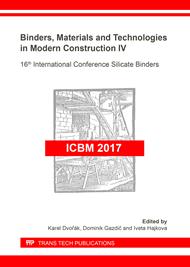[1]
H. Yan, W., Sun and H. Chen: The effect of silica fume and steel fiber on the dynamic mechanical performance of high-strength concrete, Cement Concr. Res, Vol. 29 (1999), p.423–426.
DOI: 10.1016/s0008-8846(98)00235-x
Google Scholar
[2]
Chen, Z., Yang, Y. and Y. Yao: Quasi-static and dynamic compressive mechanical properties of engineered cementitious composite incorporating ground granulated blast furnace slag, Mater. Des. Vol. 44 (2013) p.500–508.
DOI: 10.1016/j.matdes.2012.08.037
Google Scholar
[3]
Drdlová, M., Buchar, J. Ridky, R. and Krátký, J.: Blast resistance characteristics of concrete with different types of fibre reinforcement, Struct. Concrete, Vol. 16, Is. 4 (2015), pp.508-517.
DOI: 10.1002/suco.201400080
Google Scholar
[4]
Drdlová, M. Čechmánek, R. and Řídký, R.: Blast impact behaviour of concrete with different fibre reinforcement, 11th International Conference on the Mechanical and Physical Behaviour of Materials under Dynamic Loading (DYMAT), EPJ Web of Conferences, Vol. 94 (2015).
DOI: 10.1051/epjconf/20159405006
Google Scholar
[5]
Lankard, D.R.: Preparation, Applications: Slurry Infiltrated Fiber Concrete (SIFCON), Concrete International, Vol. 6, Issue 12 (1984), pp.44-47.
DOI: 10.1557/proc-42-277
Google Scholar
[6]
Drdlová, M., Řídký, R. and Čechmánek, R.: Influence of Fibre Type and Fibre Volume Fraction on Dynamic Properties of Slurry Infiltrated Fibre Concrete, Mater. Sci. Forum, Vol. 865 (2016), pp.135-140.
DOI: 10.4028/www.scientific.net/msf.865.135
Google Scholar
[7]
Drdlová, M., Sviták, O. and Prachař, V.: Slurry infiltrated fibre concrete with waste steel fibres from tires – the behaviour under static and dynamic load. Mater. Sci. Forum, Vol. 908 (2017), pp.72-82.
DOI: 10.4028/www.scientific.net/msf.908.76
Google Scholar
[8]
Wang, Z.L., Liu, Y.S., Shen, R.F.: Stress-strain relationship of steel fiber-reinforces concrete under dynamic compression. Constr. Build. Mater. Vol. 22 (2008) p.811–819.
DOI: 10.1016/j.conbuildmat.2007.01.005
Google Scholar
[9]
Rong, Z., Sun, W. and Zhang, Y.: Dynamic compression behavior of ultra-high performance cement based composites, Int. J. Impact Eng. Vol. 37 (2010), pp.515-520.
DOI: 10.1016/j.ijimpeng.2009.11.005
Google Scholar
[10]
Drdlová, M., Frank, M., Buchar, J, at al.: Effect of Nanoparticle Modification on Static and Dynamic Behaviour of Foam Based Blast Energy Absorbers, Cell. Polym., Vol. 35 (2016), pp.143-158.
DOI: 10.1177/026248931603500303
Google Scholar
[11]
Cotsovos, D.M. and Pavlovic, M.N.: Numerical investigation of concrete subjected to compressive impact loading. Part 1: A fundamental explanation for the apparent strength gain at high loading rates, Comput. Struct. 86 (1–2) (2008) 145–163.
DOI: 10.1016/j.compstruc.2007.05.014
Google Scholar
[12]
Li, Q.M. and Meng, H.: About the dynamic strength enhancement of concrete-like materials in a split Hopkinson pressure bar test, Int. J. Solids Struct. 40 (2) (2003) 343–360.
DOI: 10.1016/s0020-7683(02)00526-7
Google Scholar
[13]
Wang, S. at al.: Effect of high strain rate on compressive behavior of strain-hardening cement composite in comparison to that of ordinary fiber-reinforced concrete Constr. Build. Mater. 136 (2017) p.31–43.
DOI: 10.1016/j.conbuildmat.2016.12.183
Google Scholar
[14]
Davies, E.D.H. and Hunter, S.C.: The dynamic compression testing of solids by the method of the split Hopkinson pressure bar, J. Mech. Phys. Solids 11 (3) (1963) 155–179.
DOI: 10.1016/0022-5096(63)90050-4
Google Scholar
[15]
Li, Q., Zhao, X. and Gao, X.: Influence of steel fiber on dynamic compressive behavior of hybrid fiber ultra high toughness cementitious composites at different strain rates, Constr. Build. Mater., Vol. 125, (2016) pp.490-500.
DOI: 10.1016/j.conbuildmat.2016.08.066
Google Scholar


